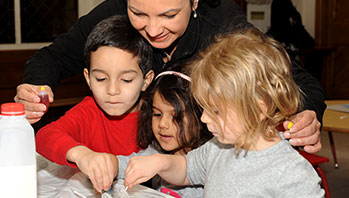- 2–3 plastic flower pots or containers with holes poked in bottom for drainage
- 3–4 onions (preferably ones that are already beginning to sprout)
- clear plastic or glass jar
- crayons or markers
- paper
- potting soil
- toothpicks
- bulb
- grow
- onion
- plant
- seed
- soil
MA Standards:
Language/L.PK.MA.6: Use words and phrases acquired through conversations, listening to books read aloud, activities, and play.
Head Start Outcomes:
Science Knowledge/Scientific Skills and Method: Uses senses and tools, including technology, to gather information, investigate materials, and observe processes and relationships.
Science Knowledge/Scientific Skills and Method: Participates in simple investigations to form hypotheses, gather observations, draw conclusions, and form generalizations.
PreK Learning Guidelines:
Science and Technology/Inquiry Skills 4: Record observations and share ideas through simple forms of representation such as drawings.
Small Group: Plant Onion Bulbs

© Commonwealth of Massachusetts, Department of Early Education and Care (Jennifer Waddell photographer). All rights reserved.
STEM Key Concepts: Plants start in different ways; Some plants start from seeds; Some plants start from bulbs; Plants grow in many places; Plants need water, food, and sunlight to grow; Plants grow in places where they get their needs met; Plants often grow in some type of dirt
ELA Focus Skills: Compare and Contrast, Speaking and Listening, Vocabulary
Safety Tips:
- Remind children to wash their hands before and after the activity.
- Remind children not to eat any plants or touch any plants without asking an adult.
Hold up an onion bulb and show children the top (pointer end) and bottom (flat end) of the bulb. Then tell children that today they are going to plant onion bulbs in the pots so they can watch what happens as they grow. Remind children that it can take a number of days before a plant sprouts.
- Guide children as they fill the containers with dirt and plant 2–3 onion bulbs in each one. Be sure they plant the bulb with the top of the bulb above the soil. Ask children, Why do you think you need to plant the bulb with the top of the bulb above the soil? (The onion stems will grow rapidly in the first week.)
- Ask children to draw or write to record what the bulb looks like on the first day.
Then tell children they are going to “plant” another onion in water. Ask children,
- Why do you think we are planting the bulbs in water this time? You may want to make a connection to the bean seeds they “planted” in plastic bottles. If children don’t grasp the concept, explain that they won’t be able to see the roots growing in the soil, but they will be able to watch the onion roots grow in the water.
- Demonstrate how to poke toothpicks into the side of an onion. Then have children balance the onion bulb across the top of a jar.
- Direct children to fill the jar with water so that it just touches the tiny roots at the base of the onion.
- Have children record the bulb in their science notebooks or on the group “Plants All Around” chart. Take photographs to record the exploration.
Tell children they will check the bulbs each day to see if there are any changes.
Then have children check the beans they placed in the plastic bottles to see if any change has happened. Ask, Do you notice any changes in the bean seeds? Discuss any changes and have children record the changes.
Math Tip: As plants grow, have children count the number of stems growing out of each onion bulb. Put a growth chart next to each onion. Record the day, and write or draw the number of stems.
Math Tip: As children check the plants’ growth, have them measure and record the length of the stems on each bulb. You may want to have them make a graph comparing the lengths on different days.
Adaptation: For groups with very young children, you may want to poke the onion with the toothpick for them or guide them with your hand over theirs.
